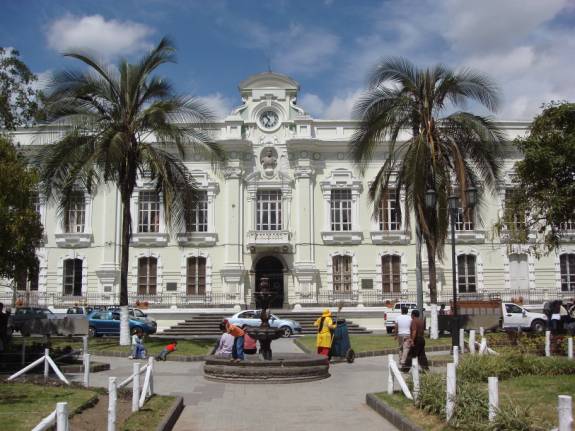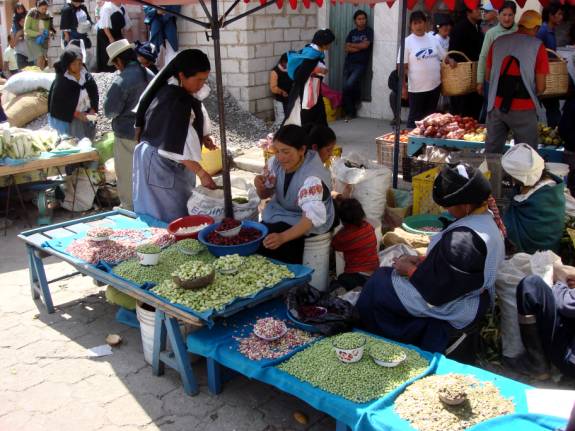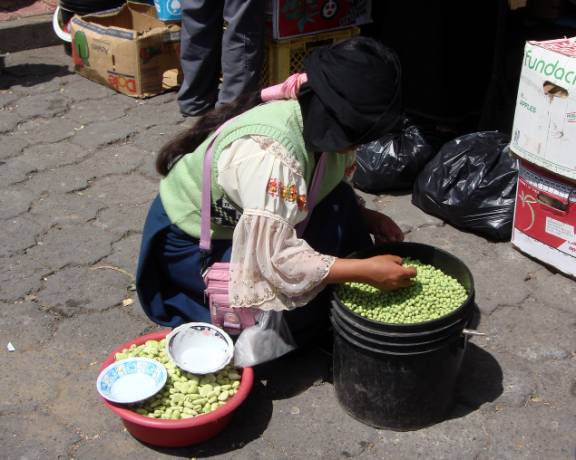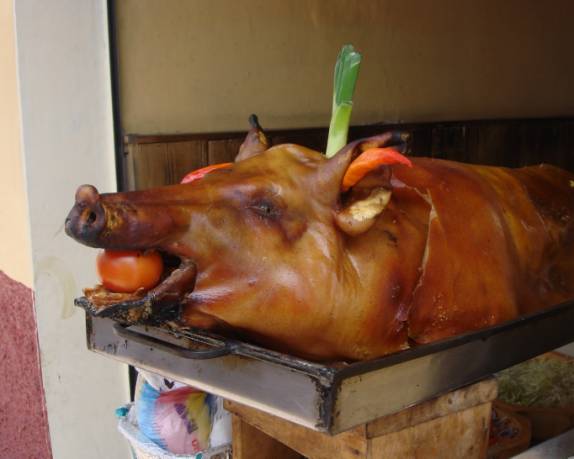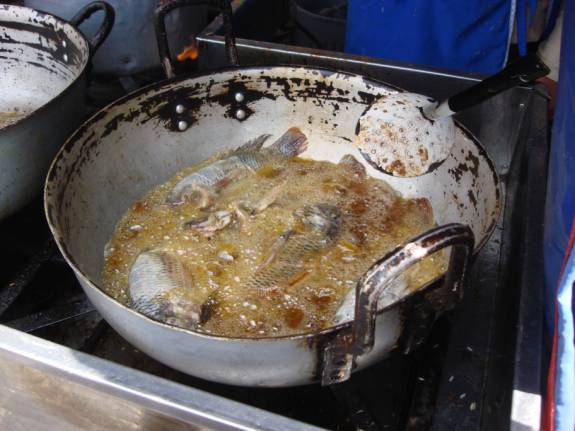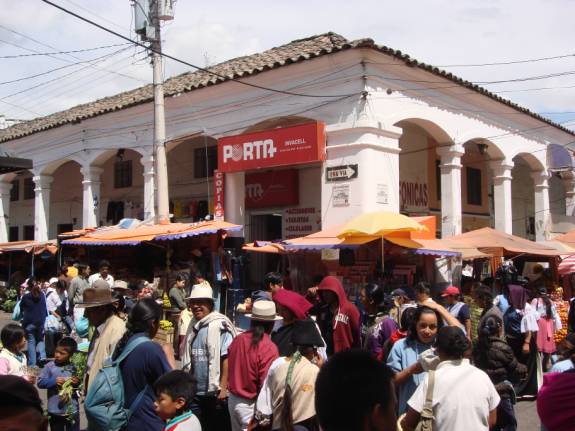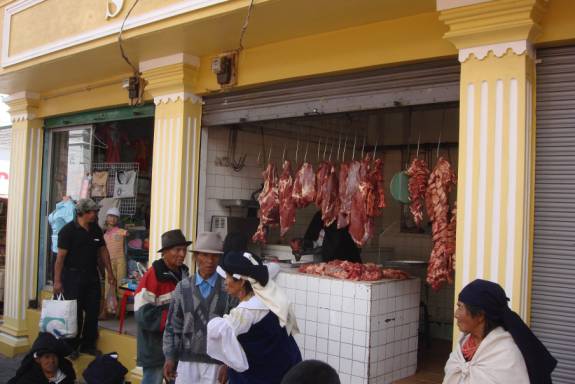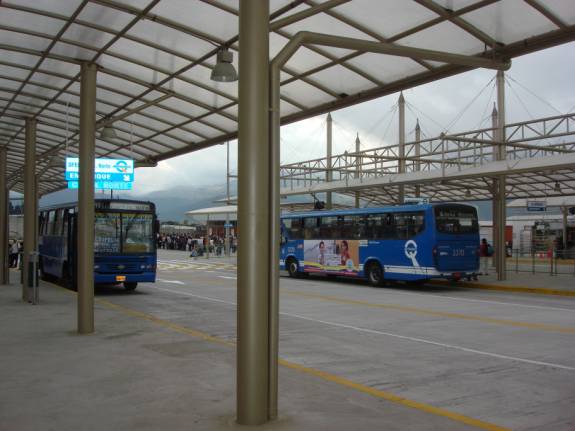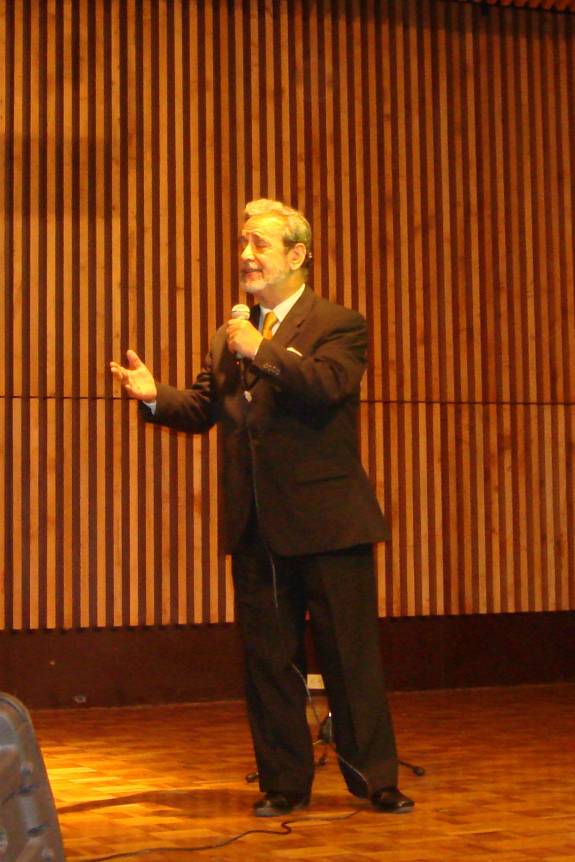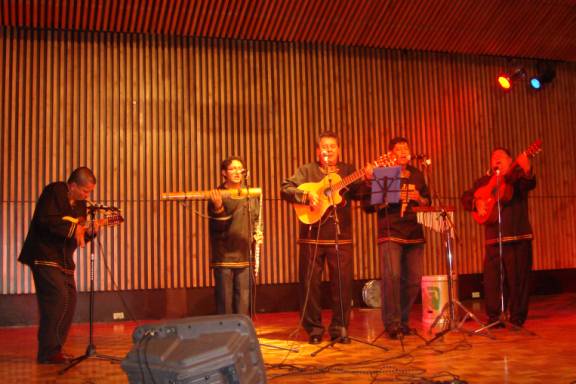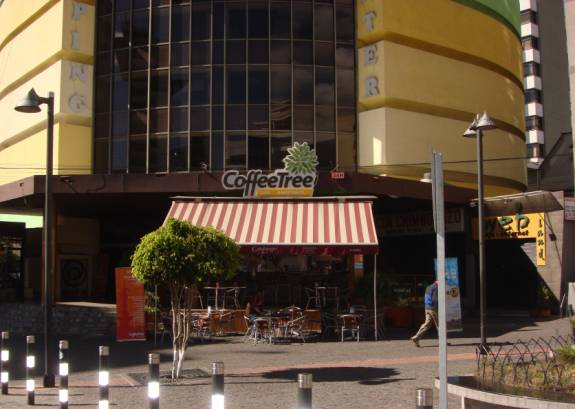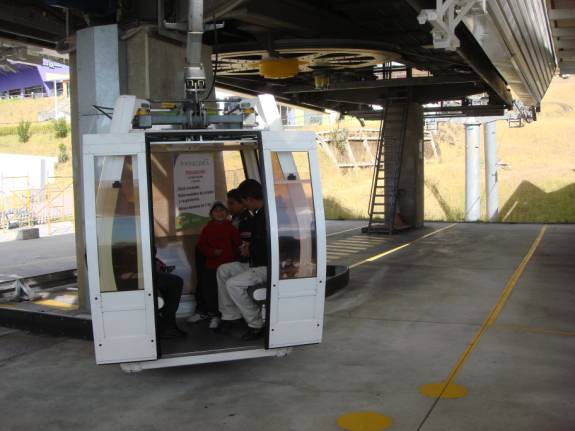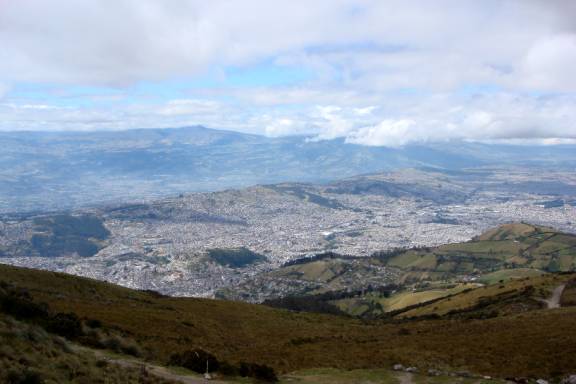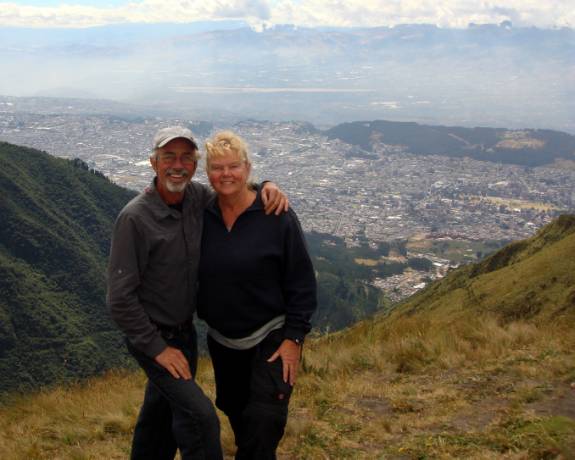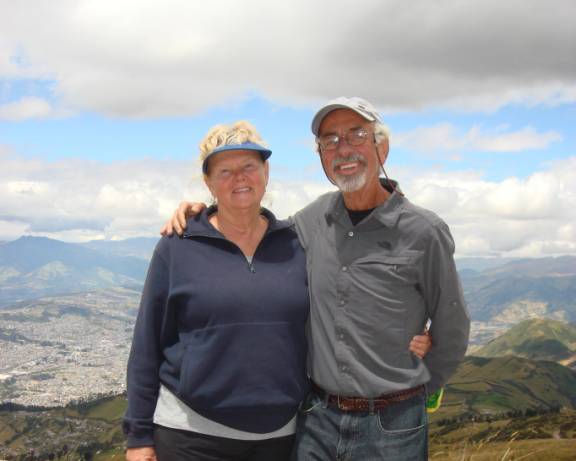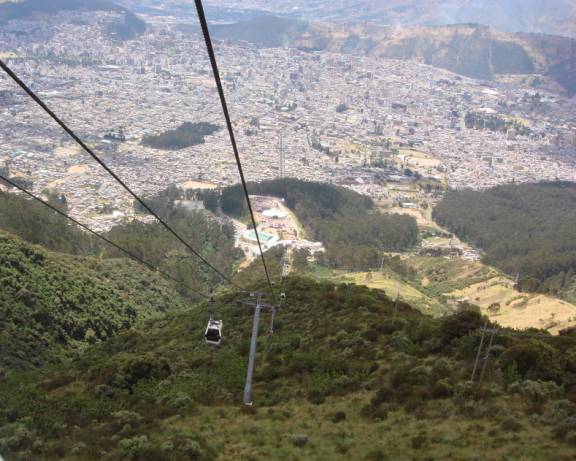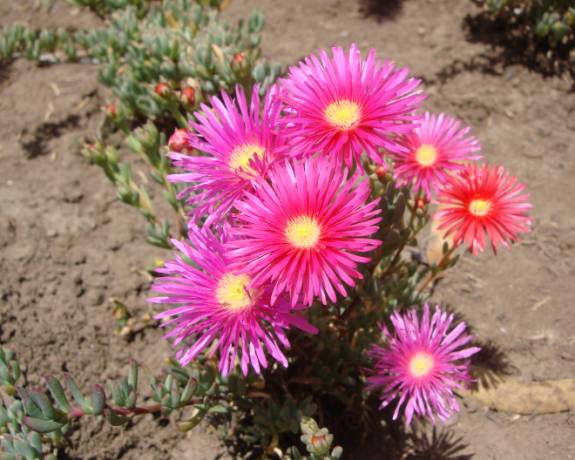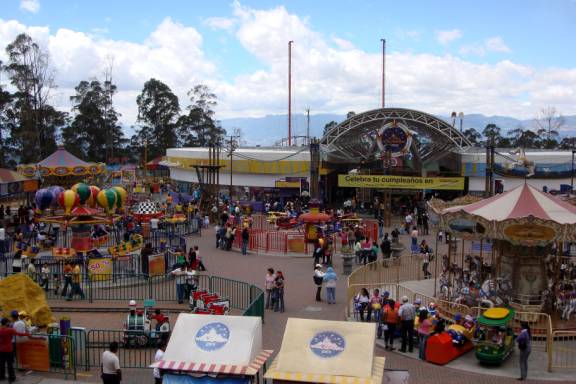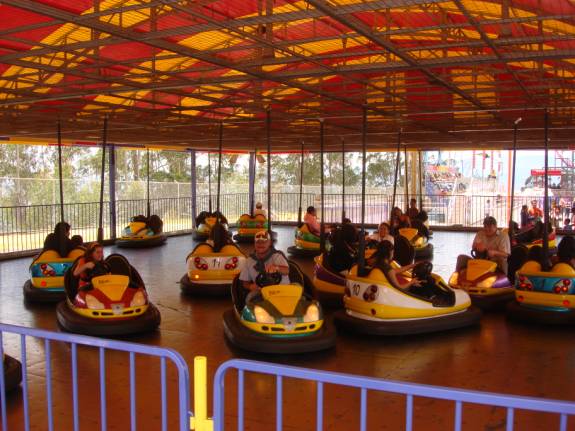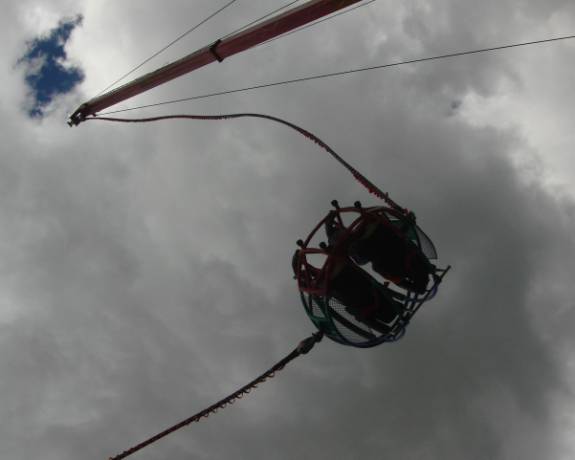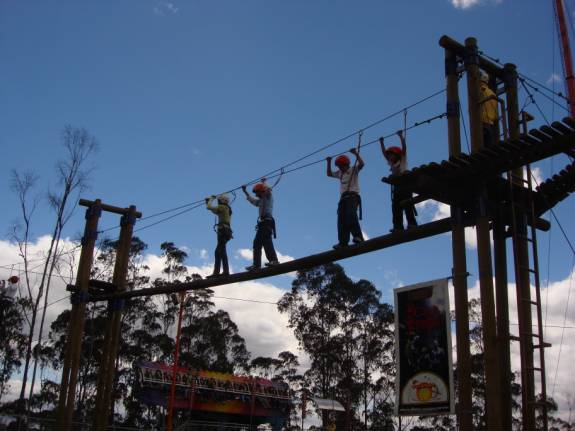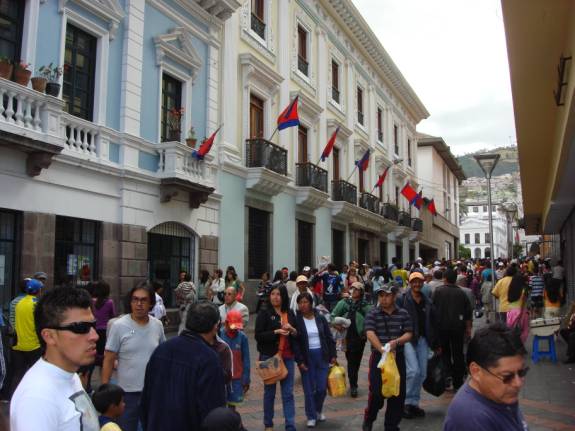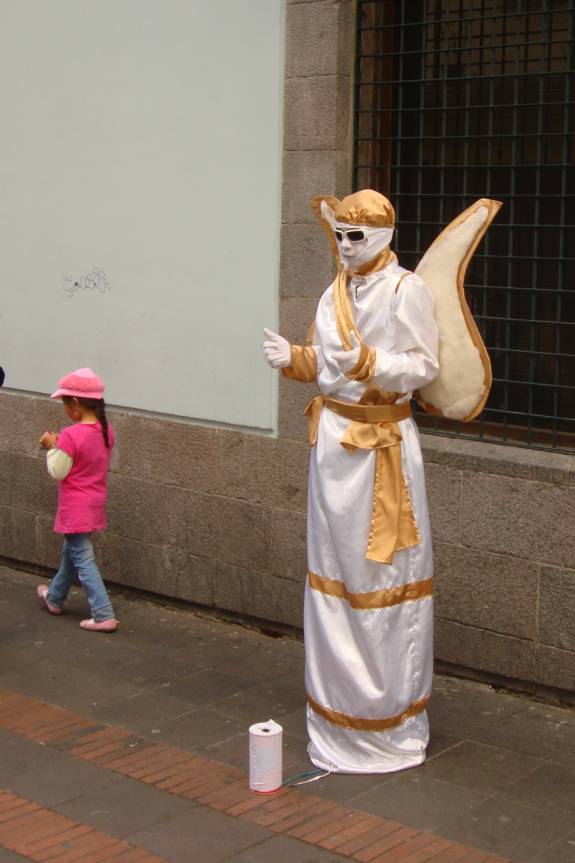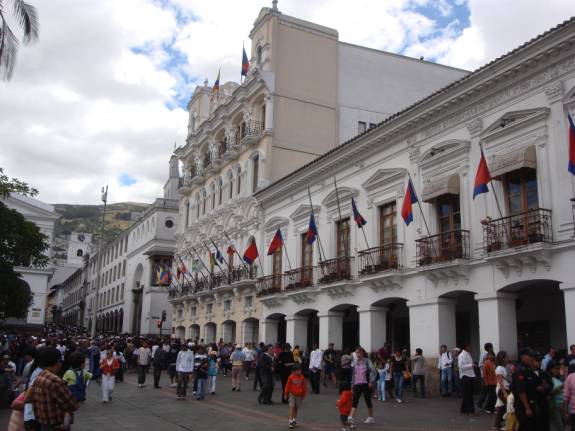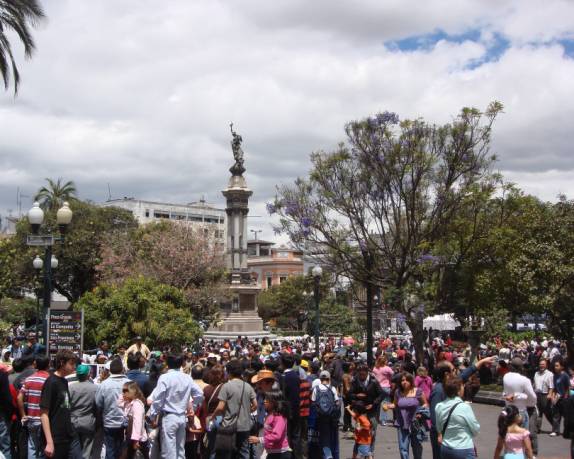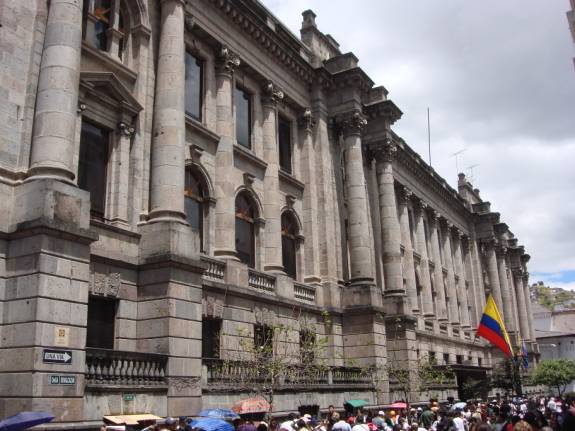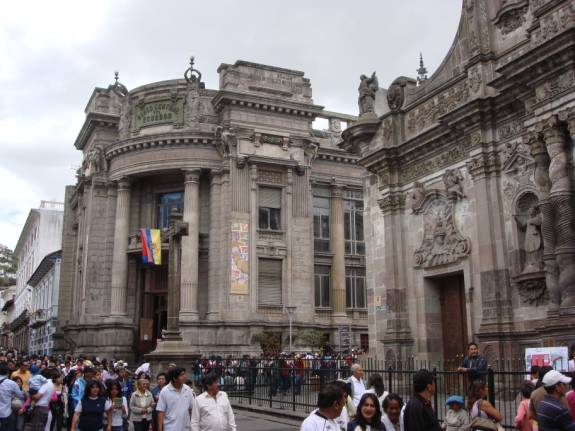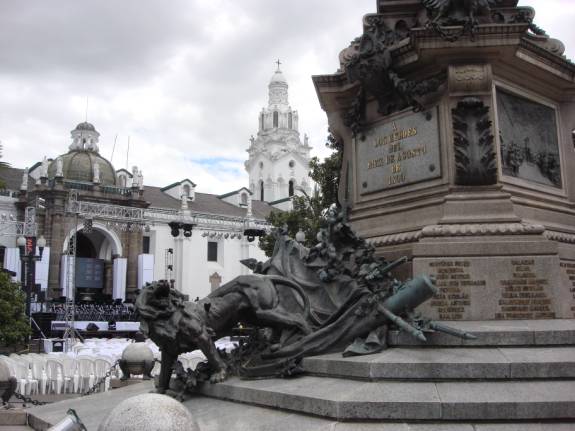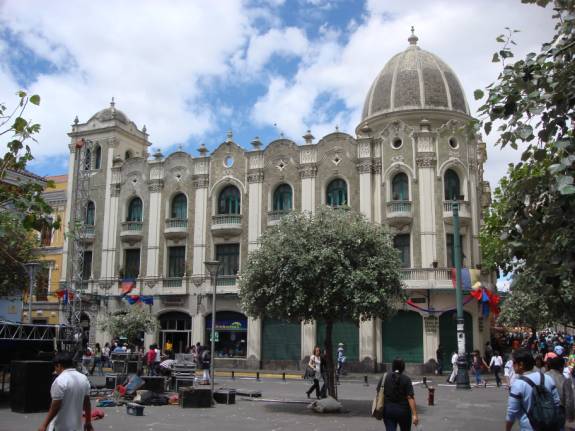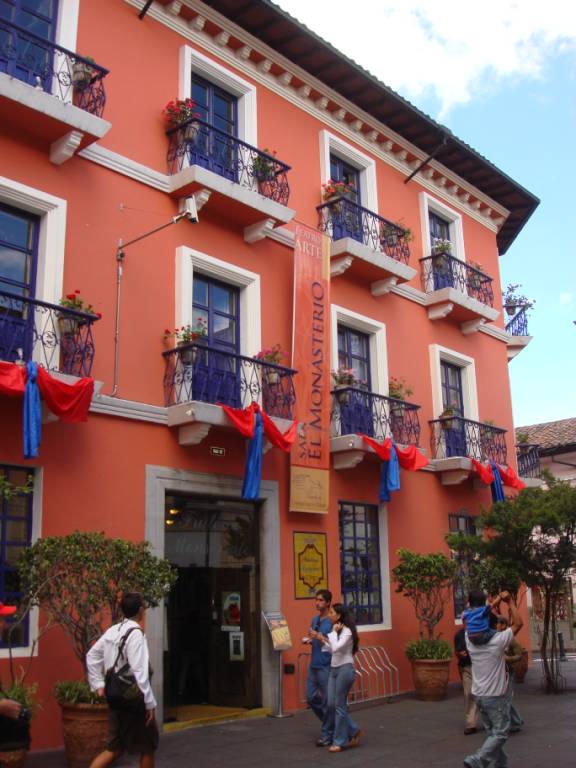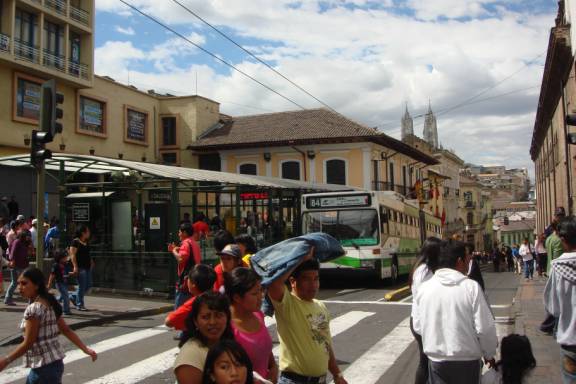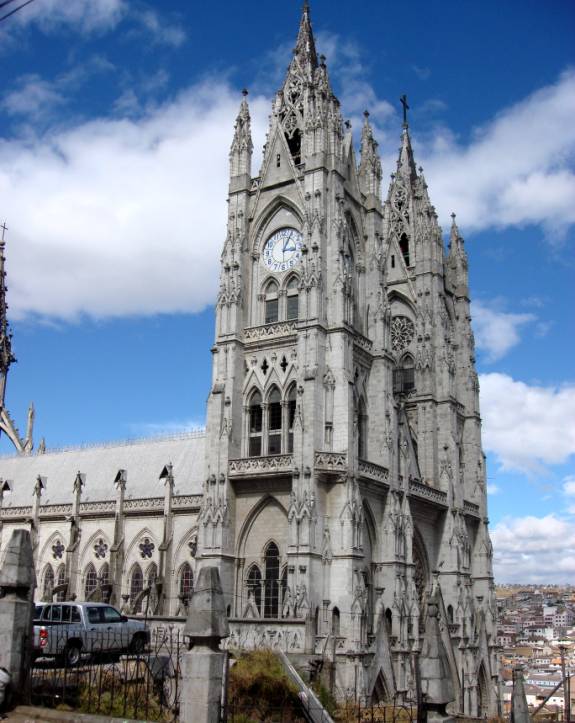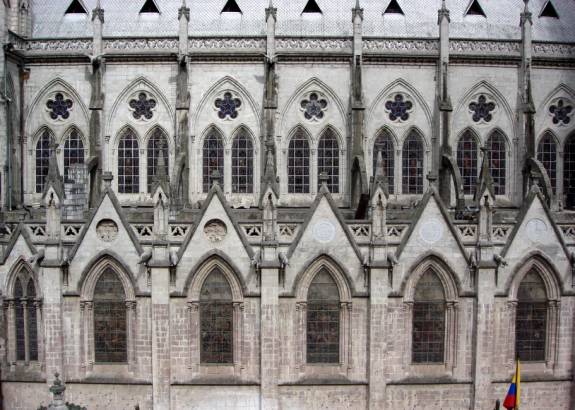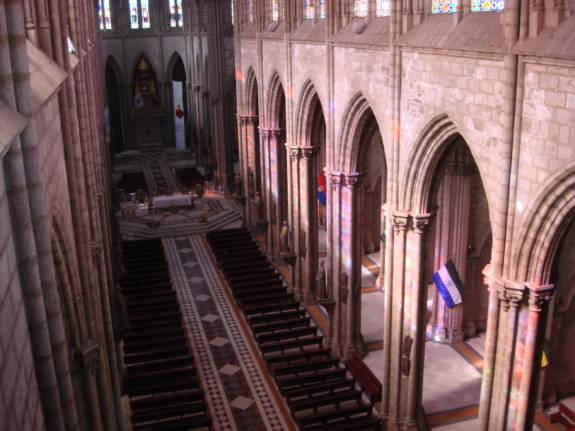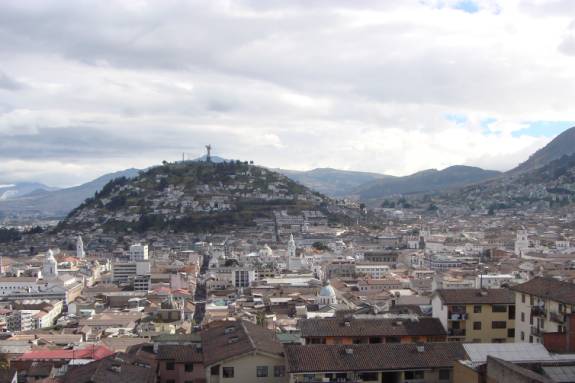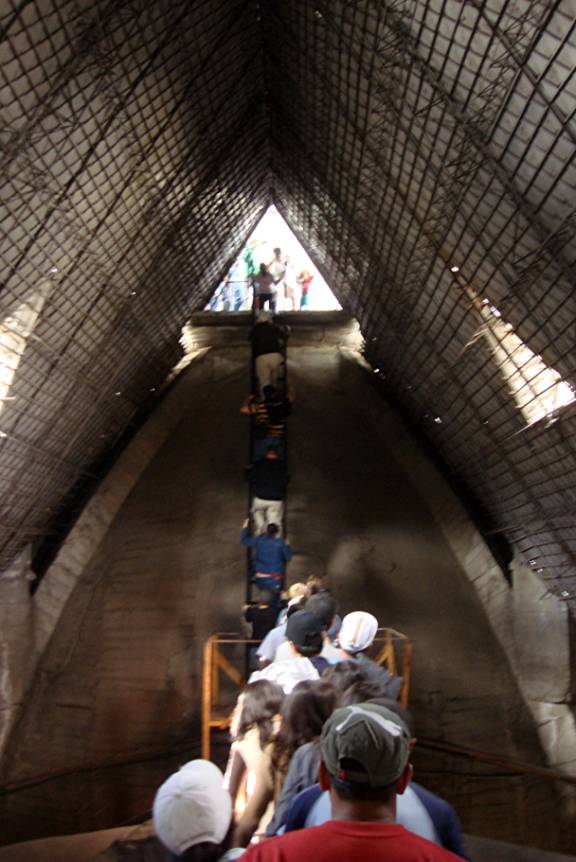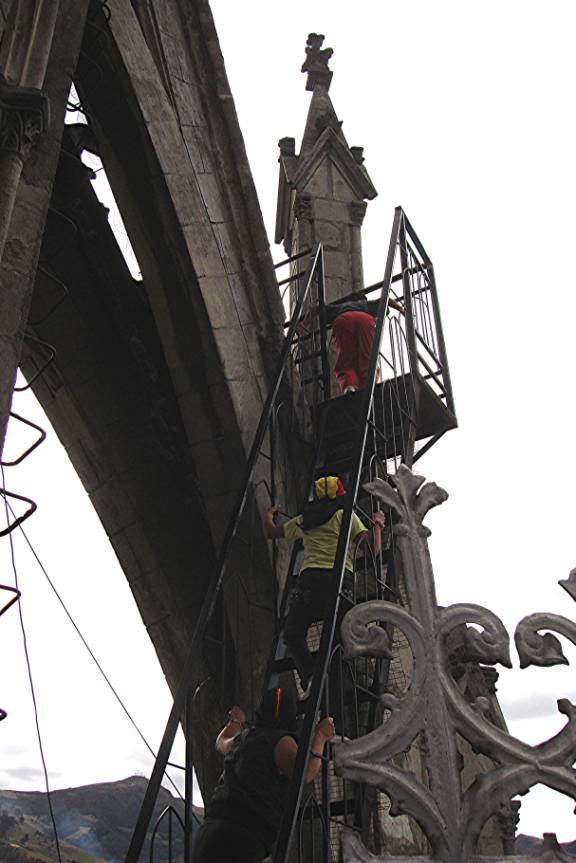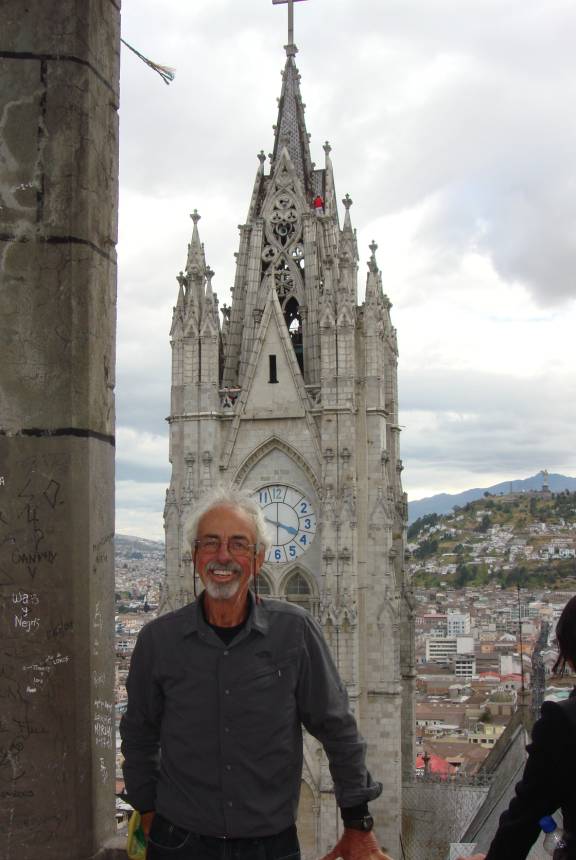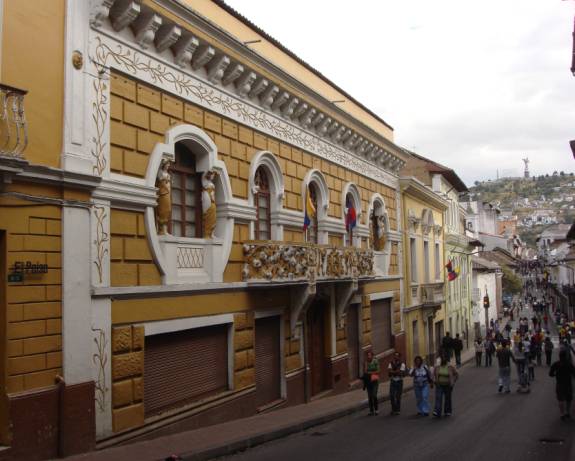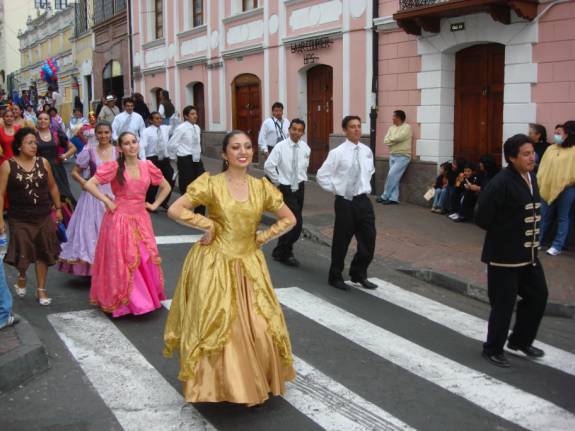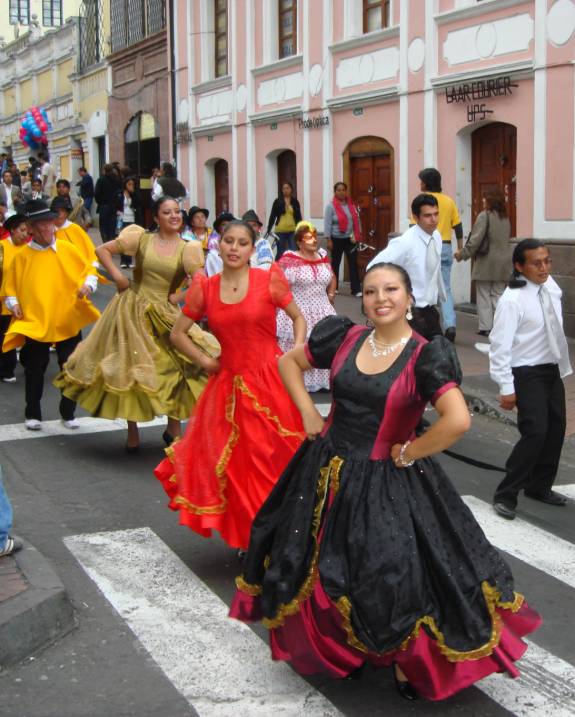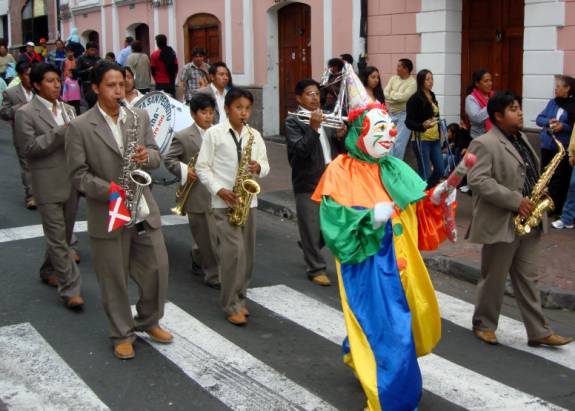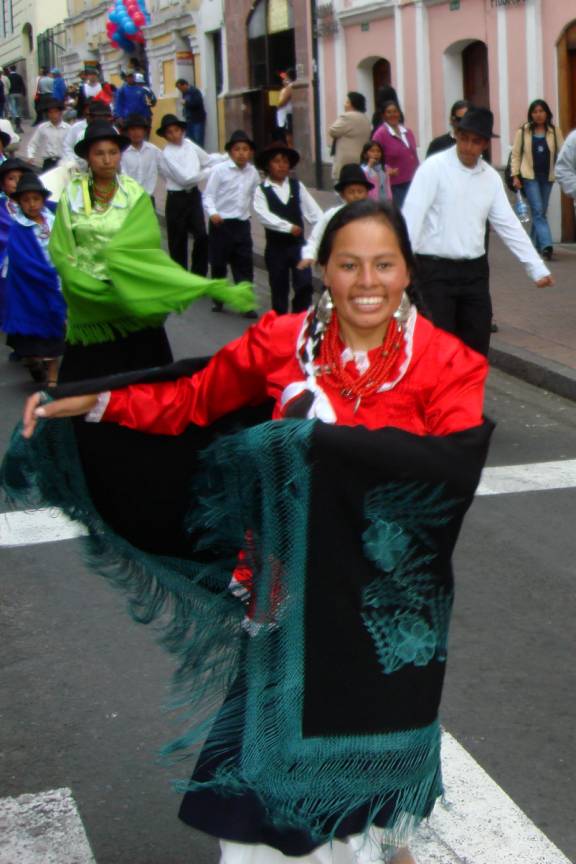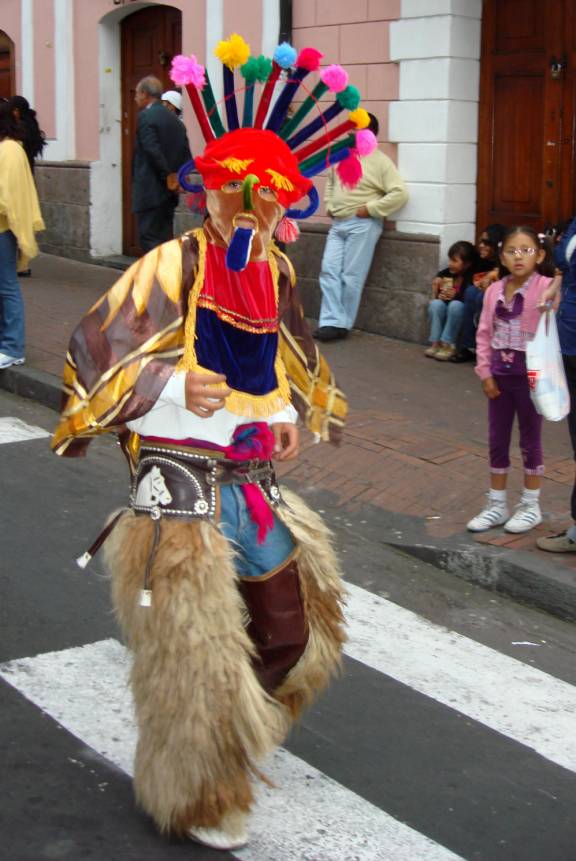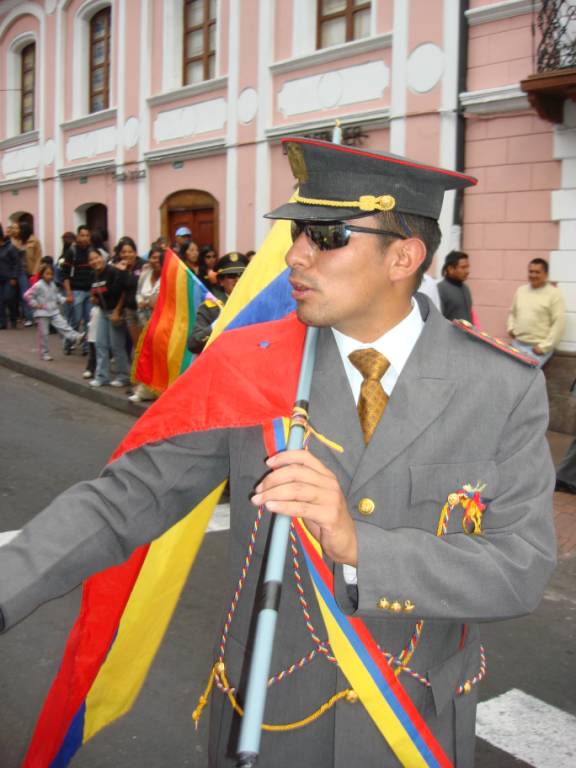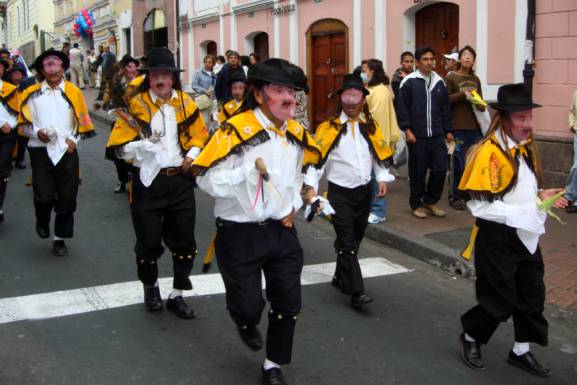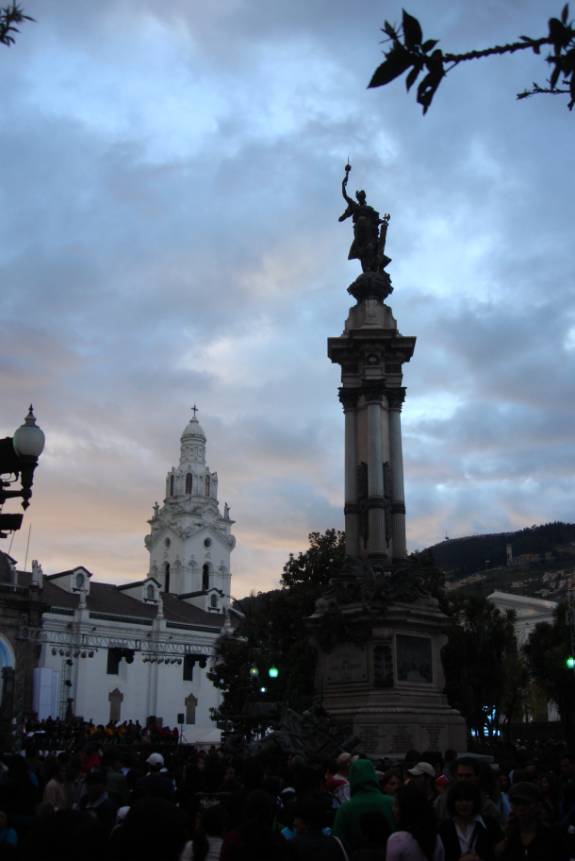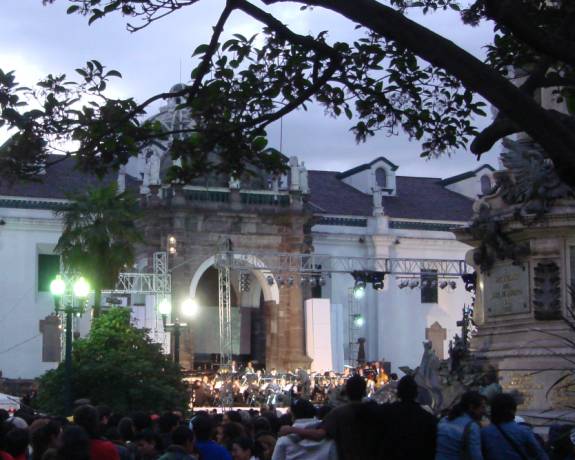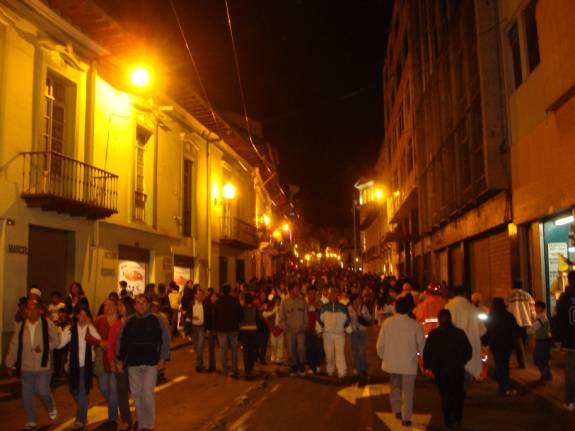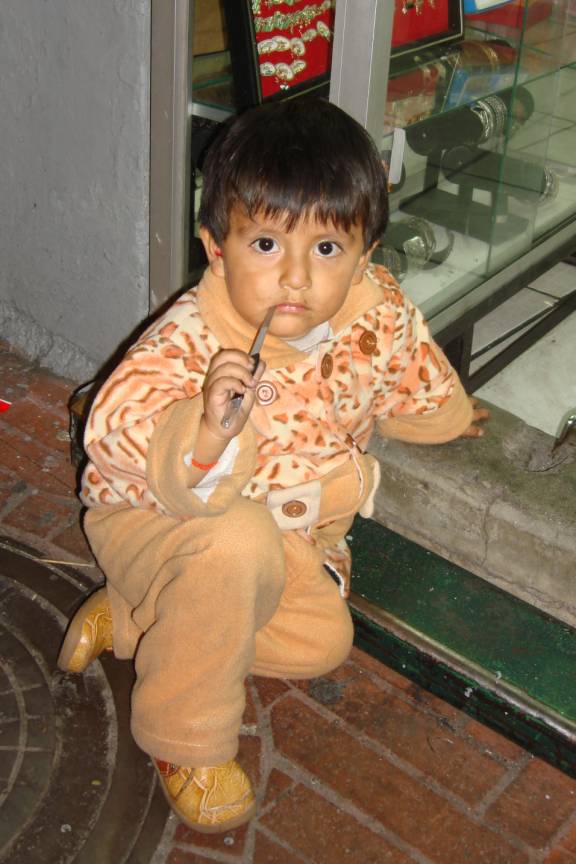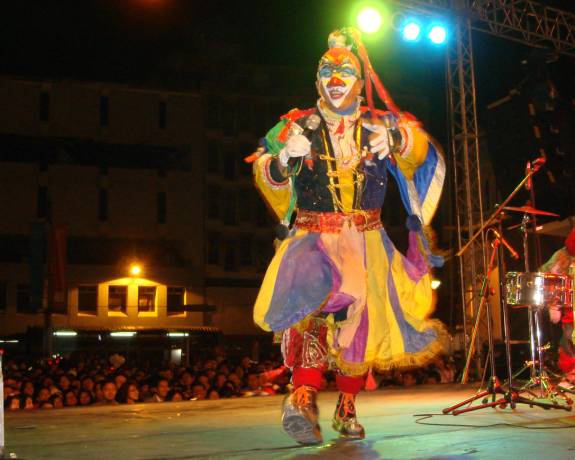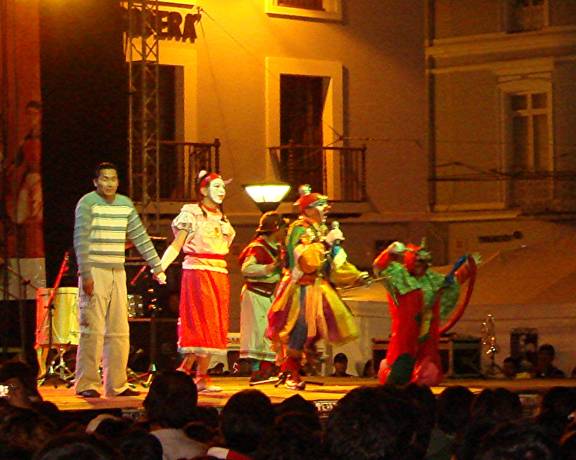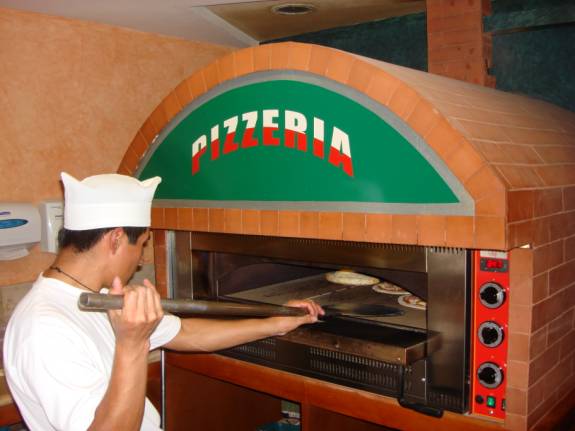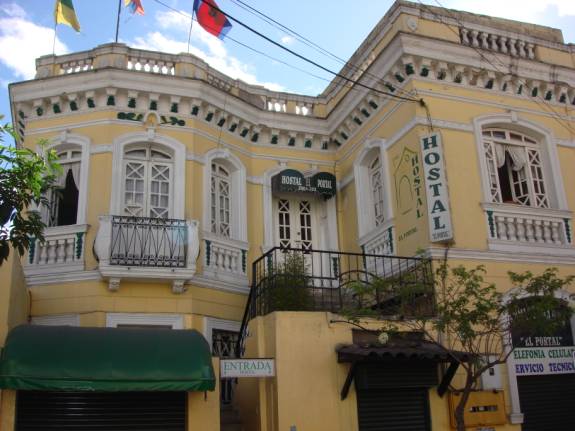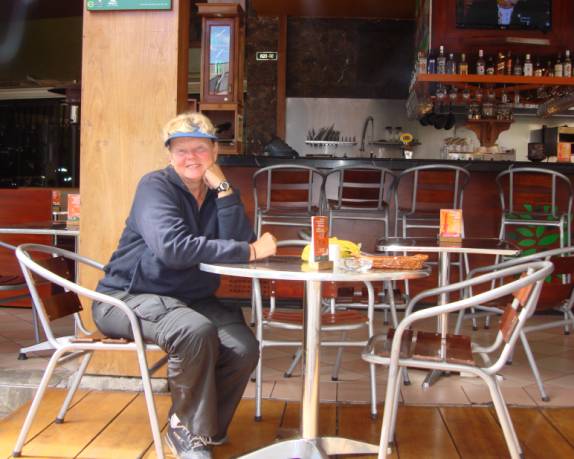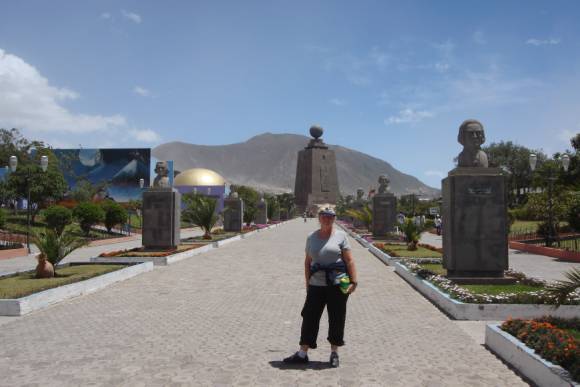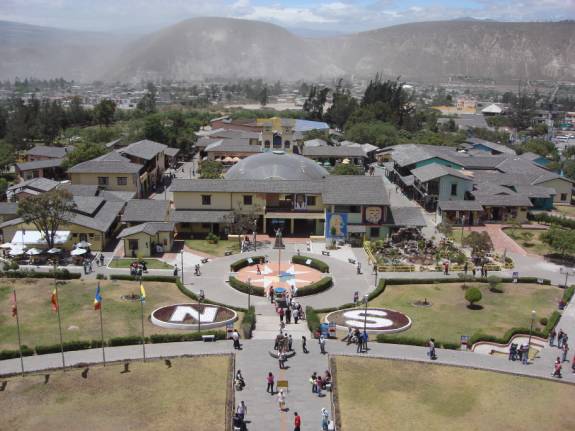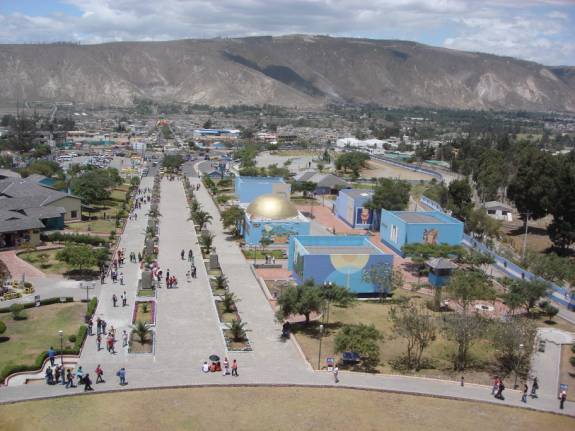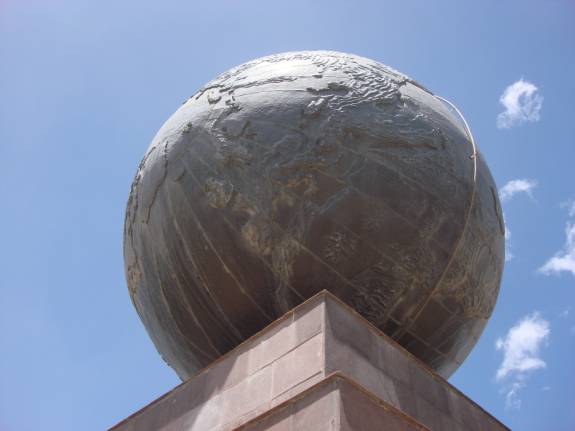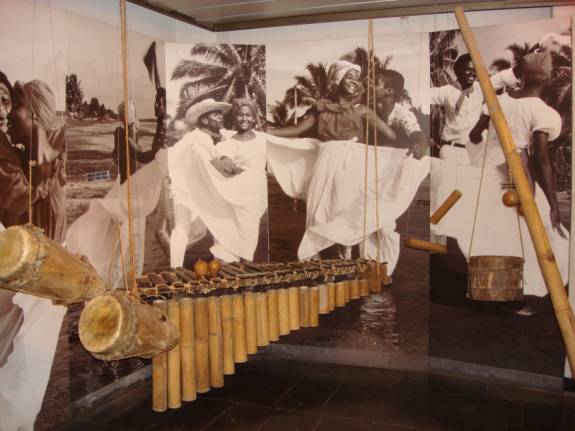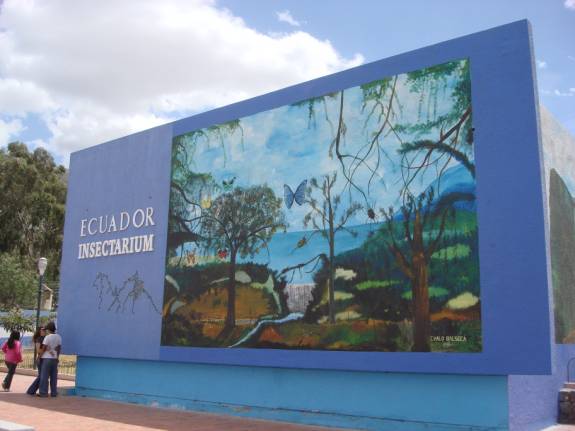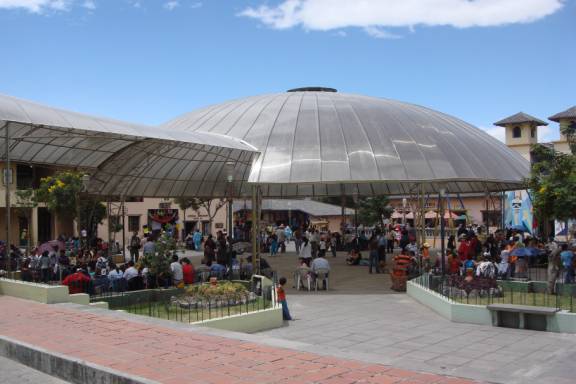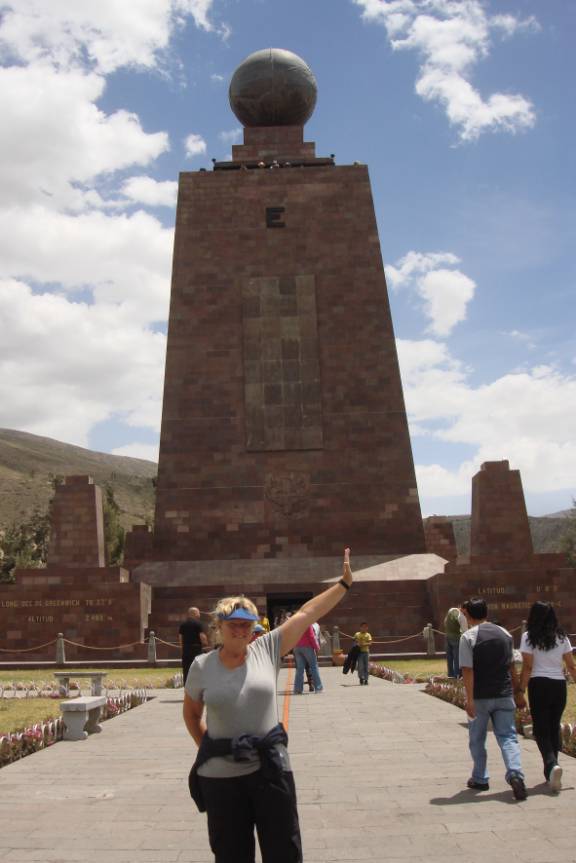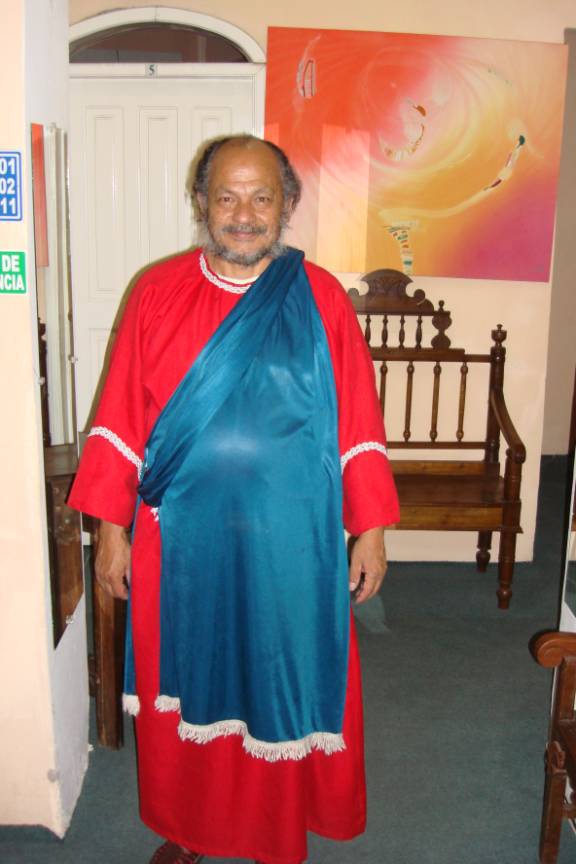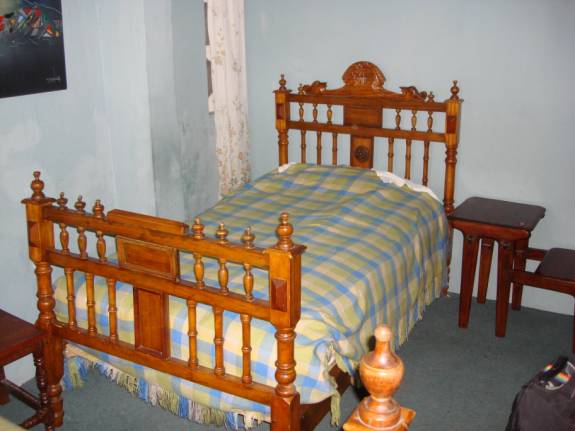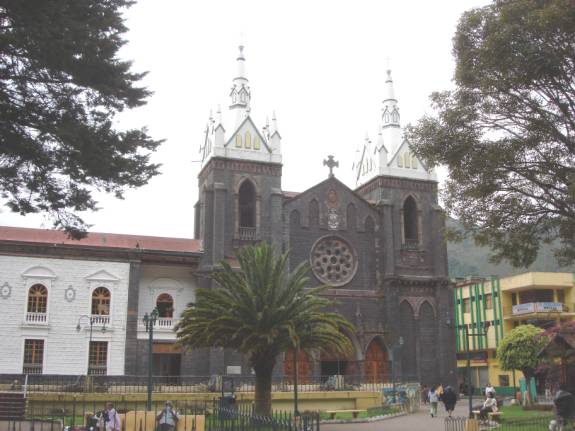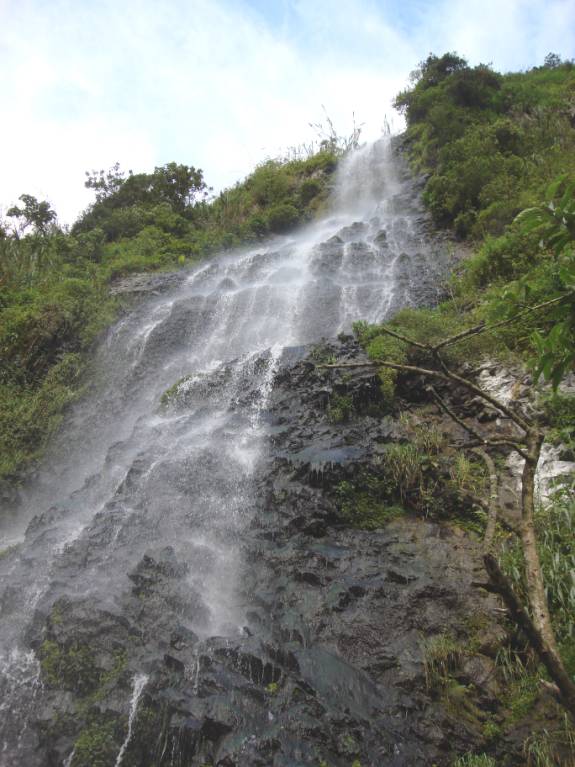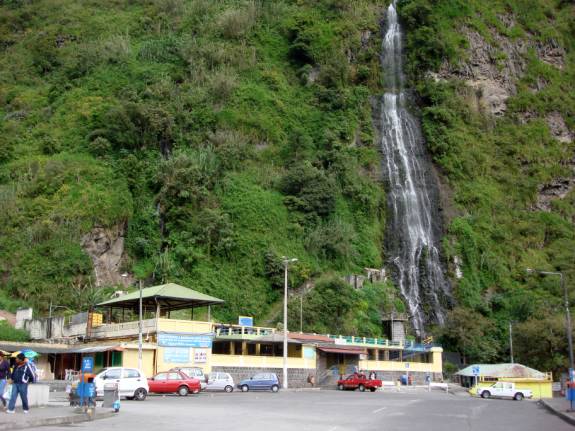|
|
|
|
Site Index:
|
UPDATE#28
08/08 thru 08/11
Howdy
Everybody, The adventures
of 2006, 2007, 2008, and 2009 through 08/07/09 have been published on the
website. We continue with the
latest edition, which is the 9th in the Series covering our Peru and Ecuador
adventures. UPDATE
2009 #28 08/08/09 thru 08/11/09 At last update,
we had just arrived in Quito, the capital of Ecuador. 08/08/09
SATURDAY QUITO, ECUADOR and
OTAVALO
I was up early trying to get some information and directions from Pablo,
the guy that kind of watches over the Hostal El Portal.
He is a really nice guy but I don’t think he is up on all the points of
interest around the city. Basically,
he is at the hostal all night, all day, every day.
The owner offered some help but I was having some difficulty getting the
facts straight. After all, these
people don’t do these things this way very often and they don’t get many
travelers inquiring about these things. I
was able to glean enough info to get us going and was trying to figure out the
rest.
The Saturday market in Otavalo is regarded as one of the most unique and
interesting indigenous markets in South America.
The main activities begin very early in the morning with an animal
market, then progresses to a general and textile market zone.
Unfortunately, we missed much of the early activity while trying to get
there by public transportation. We
needed to transfer at least three times to different lines and terminals.
It was very confusing trying to figure out the details and took about 3
hours or so to get to the northern city. If you plan on visiting this Saturday
market, I recommend that you arrive in Otavalo the day before and plan to get a
dawn start.
The central plaza area had a nice, colonial flair.
Most of the surrounding streets were taken up with all kinds of
merchandise vendors. From vegetables to textiles to artisan crafts to indigenous
clothing, the variety of products was seemingly endless.
It is very interesting to watch commerce taking place in a manner very
different from what we are used to.
Many of the vendors, especially the women, were dressed in the typical
style of these local native people.
Vibrant colors can be seen most everywhere.
Roasted whole pigs are a culinary favorite in this area.
This one looked very nicely prepared and properly cooked.
Numerous large pans of hot oil bubbled constantly as the whole fish were
frying. I seriously doubt that they
are using the low cholesterol version of Canola oil.
Adjacent to the street vendors, the more established storefronts were
open for business too. It seemed like the focus was more toward the temporary
sellers today.
Although it was a bit difficult to find an indoor restaurant, we did have
a nice brunch at the café/restaurant of the Hostal Italiana.
From a terminal-type parking lot in Otavalo, we needed to take a bus to Terminal
Carcelén (the new major terminal located in the far north of Quito).
From there, we took another bus to the Rio Coca terminal where we changed
buses to the transit system. Our
most recent Moon guidebook did not provide us with accurate or useful
information. It was very
frustrating and confusing.
In addition to the local buses, there are three major rapid transit lines
in Quito. We took the red Ecovia
line to the Casa de Cultura (cultural center).
A free concert was scheduled at 6pm.
The performances featured “Music and Dances from 24 Provinces”.
One very popular performer drew lots of cheers and applause.
He intermixed wonderful ballad songs, that everybody seemed to know, with
poetic prose. Much of it was beyond
my linguistic skills but we enjoyed the presentation and his smooth,
velvet-toned delivery.
Several different bands entertained with Ecuadorian and Andean styles of
music.
Various groups of dancers glided across the stage in typically folkloric
style and costume.
This group was especially enjoyable with their instruments and tunes of
Andean origin.
After the concert, we walked to a restaurant near our hostal.
S’Panes menu looked a bit like a Denny’s restaurant, however, the
food was just okay. Whatever, it
was open, fast, and close by. Back
at the hostal, I sat on the porch and talked with Pablo, the hostal clerk, about
the city and interesting upcoming events for the city’s celebration for their
Independence Day. I gained a lot of
information, but much of the exchange was difficult to decipher. 08/09/09
SUNDAY QUITO, ECUADOR
Judy was able to sleep until 7:30am this morning.
Within walking distance, we had found a café restaurant for breakfast.
They had very good coffee and some menu specials for the Independence Day
weekend. The slices of quiche were
quite delicious.
We hailed a taxi to take us to the famed “Teleférico”
(cable car). Actually, we had to
hail several different taxis before we could successfully bargain for a fair
price. The meter should establish
the regulation fare, however, many drivers would rather quote high, flat rate
prices (sometimes more than double) in hopes that travelers wouldn’t know the
difference. Our hostal was located
near to the expensive hotel zone by the Hyatt and Sheraton Hotels; therefore,
taxi drivers are often successful in bilking those more affluent tourists and
business travelers.
The mostly uphill taxi ride to the gondola cars was further than I had
anticipated. It would have been a real challenge and much too time
consuming to have tried to walk.
Relatively newly constructed, the
Teleférico is becoming a major
attraction for local
Quiteños,
Ecuadorian tourists, and travelers.
The
Teleférico was built adjacent to
the Volcano
Pichincha and up to the summit of
Cruz Loma. The recreation site includes an amusement park, shopping center, food
court, restaurants, handicraft shops, go car track, coffee shops, and even a
nightclub.
The major attraction it is the
Teleférico itself, enabling a spectacular view of the city and the
surrounding area. On a clear day, one might be able to see more than 14 peaks of
the Andes Mountains, sometimes called the “Avenue of the Volcanoes. The cable
car commences the climb from about 9,350 feet and reaches almost 13,300 feet MSL
on the summit of Cruz Loma.
Quito is divided into three main sectors; the Old City at the centre,
with southern and northern districts to either side. Most of the facilities for
travelers are in the northern part, including the airport. Quito's Old City and
Historic District is the largest of its kind in the Americas. Having undergone a
major restoration and revitalization program in recent years, it is said to have
some 40 churches, 17 plazas, and 16 convents and monasteries. It is highly
regarded as one of the finest examples of Spanish colonial and Independence era
architecture, history, and heritage.
Fred and Judy at the summit…
The Teleférico
started operations in 2005, offering a spectacular panorama over the city and
surrounding mountainous areas. There
are eight cars, each with a capacity of 6 riders.
The ascent takes 8 to 10 minutes traveling from 9,678 feet to13,287 feet
above mean sea level.
Even with all the manmade marvels here, I can’t seem to resist the
simple spendor of a beautiful flower…
Near the base of the
Teleférico, an amusement park provides a variety of rides, games, and
eating areas.
As a kid, the bumper cars were my favorite…
A dual seated cage plummets to the ground at the bungee jump…
Swing, baby, swing… Up, Over, and Down…
With helmets and safety straps, the kids were having a great time walking
the suspended log…
We hailed a metered taxi to the nearest station of the transit system.
The Trole line took us the rest of the way into the historic
district of the Old City.
For Ecuadorians, this weekend celebrates one of their most important
holidays, Independence Day. In the
next two days, the city will be overflowing with patriotic revelers for this 200th
Anniversary. The country will also
inaugurate its newly re-elected President on the historic day.
Throngs of people were already gathering to enjoy the festivities.
The Colonial architecture and historic buildings in the Old City are
magnificent. This one lines an
entire side of the Plaza Grande.
The delightful central plaza, called Plaza Grande or Plaza de
la Independencia,
is beautifully designed and maintained.
Many of the government buildings were open to visitors.
Long lines formed outside with those hoping to see the interior portions.
The National Cathedral is seen in the background.
An enormous monument dominates the Plaza de la
Independencia. It
commemorates the heroes of the August 10, 1809 Independence movement.
On that date, the first cry for independence was given in the Primer
Grito de la Independencia.
The initiated movement would free the people from nearly 300 years of
Spanish rule.
Fabulous buildings are everywhere…
In this colorful building, we ate our lunch at the restaurant,
Frutería Monserrat.
The food was excellent. If
you go here, be sure to try the Ensalada de Frutas (Fruit Salad).
As their name might imply, it’s one of their wonderful specialties.
There are three rapid transit lines in Quito.
This green, electrically powered vehicle runs on the Trole route
and is dropping more revelers at the Plaza Grande station in heart of the Old
City historical district.
From the central plaza, we walked up the steep hill leading to the
Basilica del Voto Nacional
(Basilica of the National Vow). With
the high altitude of this city, it was a strenuous climb.
Even though the first stone was laid on July 10th, 1892, it
remains technically "unfinished." Local legend purports that when the
Basílica is completed, the end of the world will come.
The Basilica features arched trusses and numerous gargoyles depicting
animals and birds that may be found in Ecuador.
A prominent hill, called
Cerro El Panecillo, because of its
resemblence to a small loaf of bread, rises more than 650 feet above the
surrounding terrain south of Old Town Quito. With its peak almost 9900 feet
above sea level, it is a focal point just south of the Old City center.
According to a Jesuit historian, there was a temple from which the Inca
people worshiped the sun. Local legend says that this temple was destroyed by
the Spanish conquistadores.
The unique and artistically created
Virgen del
Panecillo statue is 148 ft. tall
and is an enlarged representation of Bernardo de Legarda's “La Virgen de
Quito” sculpture that is displayed on the altar of the San Francisco church.
The statue is made up of some 7,000 pieces of aluminum and it is renowned as one
of the greatest aluminum sculptures in the world.
A bronze placard indicates that the monument represents the Madonna as the
“Woman of the Apocolypse” as referenced in the Christian Bible (Book of
Revelations).
This is something you can’t do in many places.
You can have the opportunity to walk a narrow plank across the upper
portion of the sanctuary’s arched roof, climb some rickety ladders and stairs,
and enter the bell tower.
For the route back down, we took a different street.
Lined with more beautiful buildings, the walk was much less strenuous.
A great parade of people in historical dress was wonderful.
Just look at the traditional pride and gleeful smiles that grace these
young people.
Back at the Plaza de la Independencia (Plaza Grande), the setting sun
gave silhouette to the Monument to the Heroes and the Cathedral in the
background.
Like kids around the world, this little Ecuadorian girl couldn’t resist
playing in the dirt.
On a stage set at the Cathedral, the National Symphony Orchestra played a
wonderful concert for all to enjoy. Several
famous Ecuadorian singing stars added to the evening performance.
An impressive light and sound system amplified the audio and visual
effects. In several places in the
plaza, huge screens provided close-up viewing.
As esthetic lighting illuminated the architectural features, the
orchestra played on…
The massive crowds meandered around the Old City streets enjoying the
numerous entertainment stages scattered throughout the area.
Just look at those beautiful eyes…
Dancers and storytellers fascinated large crowds of smiling and laughing
Ecuadorians…
At Plaza Teatro
(Theatre Plaza)…
This story tells of a crazy cow (Vaca
Loca) that falls in love with a peasant man.
The comedy act delighted everyone and drew lots of cheers and laughter.
For dinner, we visited El
Fornace (The Furnace) restaurant/pizzeria.
In addition to their pizza and
calzones, they serve some of the best ice cream dishes that you could
imagine.
When the time came to leave the Old City for the return to our hostal, we
had a difficult time finding transportation.
With so many people needing a way out, we thought is strange that the
main transit line for that route had already shut down for the night by 9pm. After walking to a major thoroughfare, we tried to hail a
taxi, but they were all full. We
tried to find a bus, but they were all going somewhere else. I decided that we should walk somewhere else, away from the
central area, in hopes of finding a taxi. With
a little hope and some very good luck, we walked in just the right direction and
came upon a terminal stop for the Ecovia transit line.
After a relatively short wait in line, we hopped aboard the “Red
Line” that would take us to the general area of our hostal.
From the “Parada Casa Cultura” (transit stop), we had only a
20-minute walk to El Portal. We
were very tired and chilly. At
midnight, it was a joy and honor to be the one to give Judy the first kiss of
her birthday. 08/10/09
MONDAY QUITO, ECUADOR A VERY
SPECIAL AND HAPPY BIRTHDAY to JUDY, MY LOVE…
Everyone else was claiming that all the festivities were for the
Bi-Centennial and today’s inauguration of the President of Ecuador.
I am solid in my belief that everything was, primarily, in special
celebration of Judy’s birthday and that, perhaps, all of those other
celebrations were just mere coincidences. What
do you think?
It was still quite early when we left the Hostal El Portal and
walked about on the adjacent streets.
Today, my thoughts encompassed a plan to make everything very special for
Judy's birthday. The morning
started with a wonderfully delicious coffee, juice, and mushroom quiche
breakfast at the Coffee Tree Restaurant.
We walked to the closest stop for the Trole transit line, taking
it to the North Terminus. I had to
ask a lot of questions to find the next connection, which was finally found
several blocks from there.
We boarded a MetroBus and headed for the “Mitad
del Mundo” (Middle of the World). A
100-foot tall monument marks the point where the equator passes through the
middle of the earth. It was this
place on the equator that provided the origin of the country’s name, Ecuador.
A line drawn down from the center of the east-facing stairway and across
the plaza delineates the location of the equator.
From atop the monument, the view of the main walk of statues and museum
buildings is impressive.
The pyramidal monument is
topped by a 15-foot diameter, 10,000 pound globe.
Each side of the building structure faces one of the cardinal directions;
North, East, South, and West.
A museum inside the
monument displays the diversity of indigenous Ecuadorian cultures and includes
items of typical clothing, descriptions of the various ethnic groups, and offers
explanations of their different lifestyles.
The grounds are artistically landscaped with statues, flowers, plants,
shrubs, and fountains.
The very interesting Insectarium displays a large number of both
live and display-mounted insects and crawly creatures that typically inhabit the
country of Ecuador.
Attempting to replicate a
small Colonial Spanish town, an area called "Ciudad Mitad del Mundo"
(Middle of the World City) has a collection of shops, restaurants, and various
facilities to serve the thousands of visitors that come here.
On a metal domed entertainment stage, a popular Ecuadorian band group was
rousing the audience to dance and sing along.
So far, I think we’ve been successful in making this a very special
day. What could be more unique and
unusual than celebrating your birthday straddling both the northern and southern
hemispheres?
The way back to the city turned out to be an interesting challenge.
We chose to take the MetroBus line for the return inbound.
The bus dropped us off in the middle of nowhere.
Despite a bit of confusion from the guidebook, we were able to figure out
a way back to the Trole line at the Ejido stopping point.
Guess what? The station and
line were temporarily closed because of the Presidential Inauguration events
being held downtown. We walked
quite an additional distance around the area park to the Ecovia transit
line for continuing transportation to the Old City zone.
After spending a while in the historic district and having lunch, we were
able to take the Trole transit line further south to the El
Recreo terminal. There,
we had to change to another bus to reach the newly opened, southern bus
terminal, Terminal Quicumbe. The
guidebook was of no help and attempts to get local directions resulted in
erroneous responses because of the unusual holiday changes.
With some difficulty, tempered by a little bit of street savvy, we
managed to figure out how to get there to where all major, southbound intercity
bus companies depart. Our purpose
here was to gather info and schedules for our planned departure from Quito
tomorrow morning.
With a loose plan formulating, we had no problems making the change
connection at El Recreo and continuing on to the La Mariscal
transit stop on the Trole line.
For her birthday dinner, Judy asked to return to the Texas Ranch
Restaurant for a Filet Mignon steak dinner.
Once again, we had great service and a great meal.
From there, we walked over to a popular coffee shop, called “The
Magic Bean”, for coffee and her birthday dessert. Happy Birthday, Babe,
Happy Birthday!
It was late, we were tuckered out, and, for the sake of safety, we took a
taxi back to the Hostal El Portal. Our
friendly and dependable clerk, Pablo, was there to unlock the doors and let us
in. Born in Columbia, but now
living in Quito, his unusual style of clothing represents his religious beliefs.
I am pleased that I was also the one privileged to give Judy that
important last kiss of her special birthday celebration. 08/11/09
TUESDAY QUITO to BAÑOS,
ECUADOR
Following a 6am alarm, we walked to the Coffee Tree café 30 minutes
later. Although our quick breakfast
was good, the prices had risen significantly without the holiday specials.
We picked up our travel bags and checked out of the Hostal El Portal.
I had considered taking a taxi to the south terminal.
Pablo urged us to use the local knowledge and experience we had learned
yesterday to take the public transit system and to save a lot of money.
We walked to Ejido station on the Trole transit line.
A change at El Recreo was needed to continue on to the Terminal
Terrestre (land terminal) called Terminal Quicumbe. Instead of a $20 taxi fare, our transit fare was 25 cents
each.
Arriving at 8:15am, we were able to get tickets for an 8:30am departure
on Centinela
de Oriente bus
lines.
Passing
Latacunga at 10am and
Ambato at 10:45am, we arrived at our destination, the city of
Baños,
at 11:40am. While Judy watched our
bags from a seat in the garden setting of Plaza Central, I went off in search of
accommodations. After looking at
several different places, I settled on the Hostal Grand Rio.
It took some bargaining, but I was able to get a favorable rate in the
very nice hostal for only $14 per night. We walked all around the small town center
area and had lunch at the Mercedes Café restaurant.
The Cathedral near the Plaza Principal has an unusual, black stone
construction. The
Basilica of the Virgin of the Holy Water, Nuestra Señora del Agua Santa,
is a sacred place of pilgrimage for those who come to give thanks to the Holy
Virgin for her many miracles and to ask for her special blessings. Built in
neo-gothic architectural styling, the church was constructed from local volcanic
rock in the early 1900’s.
This is a very popular tourist town that caters mainly to Ecuadorians,
but pleasantly entertains travelers from all points of the globe.
We thought this tourist train vehicle to be one of the most unusual of
its type that we’ve ever seen. It
pulls a train of several passenger gondolas behind it.
La
Cascada de La Virgen del
Agua Santa (waterfall)
spews its waters down the steep cliff.
Water from the falls is redirected into these community clothes washing
basins. Local villagers and
townspeople gather here to launder their clothes as they have done for many
decades.
Baños,
as its name implies,
is mostly renowned and famous for the natural, mineral-rich Aguas Termales
(thermal waters). The building
below the falls houses the outdoor thermal pools and related facilities.
Although there are several other pool centers in the town, this one seems
to be the favorite for its really hot, mineral water.
A very nice grocery store, 9:9, supplied the groceries for our dinner.
In the hostal’s guest kitchen, I prepared an excellent meal of
Spaghetti Bolognese. Accented with
a bottle of flavorful red wine, we couldn’t have enjoyed our evening more.
The weather today had been cool and breezy with intermittent misty
conditions. Overnight, a light rain
sprinkled down on the sleepy town. CONTINUING
UPDATES ARE IN PROGRESS…
WATCH
FOR THEM, COMING SOON… POST SCRIPT:
We sincerely hope that you will review the previous years of compilations
to give context to the current editions. Please
let us know if you have any special suggestions and thoughts.
REMEMBER: The website
is now fully active and you can visit it at any time.
You can also review any of the previous logs from the years 2006, 2007,
or 2008 and learn more about the crew and their many adventures.
Enjoy. ATTENTION:
SPECIAL NOTE:
You may contact us via email anytime. Thanks
for allowing us to share our life and adventures with you. Lotsa
Luv, Fred
Reed and Judy Law AMARSE MT40 "AMARSE"
is pronounced "AM-ARE-SAY".
Our website is: www.amarse.net .
|
|
Fred H. Reed |
www.amarse.net © 2006 2007 2008 2009 2010 2011 |


